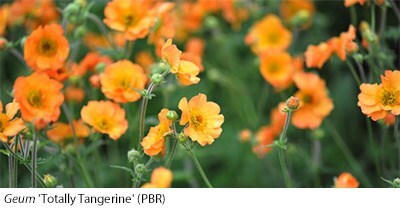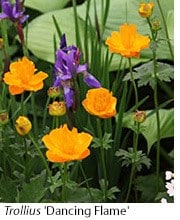Top notch perennials
The trick is to select the very best plants, because most of us haven’t got space for the also rans or frankly the poor. We want the crème de la crème, the plants that not only look lovely but perform for a long time. We want them to return year after year and be good neighbours, ones that won’t muscle in on other things. With this in mind, it always helps to look for an AGM award, as this is a reliable indicator of a great plant.
Learn to love colour when choosing plants, because the days of the pastel English country garden that looks like a watercolour painting have largely gone. Also, try to avoid planting only one of each thing as this will resemble a pincushion of dots. Far better to plant in threes, fives or sevens, always odd numbers, and avoid forming cloud-like blobs. Make a triangular shape, or a narrow ribbon that looks like its waving in the wind. This is much more pleasing on the eye.
Sunset Shades

Embrace orange and warm peachy shades because they make blue and purple more vibrant, especially in evening light. Begin by finding room for a tall geum called ‘Totally Tangerine’, a recently bred plant but already among the top rank. This will begin to flower in April, putting up tall wiry stems capable of weaving through other plants, and it will still be going in November because it’s a sterile hybrid incapable of setting seed. The colour is far from tangerine, more of a soft pumpkin orange with pale apricot, so this dainty geum casts a subtle spell like tiny fairy lights in a border. These pinpricks of warm colour could mingle with the slate-blue starry flowers of Amsonia tabernaemontana var. salicifolia, or arrange themselves over and among the slender copper-orange leaves of the sedge Carex testacea. Grasses always add movement and some give a year-long presence. They also unify a scheme when woven through a mixed border.
 A brighter shade of orange can be had from another long-flowering geum called ‘Prinses Juliana’. This shorter geum, with semi-double flowers on foot-high stems, gives a fourteen week display beginning in late May or June. Find a front of the border position and do plant a drift, for bright showy colours need to be woven through a border to avoid looking like a blot on the landscape. Use Stipa tenuissima, the pale green ponytail grass that resembles a fine optic lamp, or irises such as the mulberry petalled Iris ‘Ever After’. This may sound a strange colour combination, but bearded irises often have orange beards on their falls, so the two will marry together easily. Learn to look for minute detail when blending flowers!
A brighter shade of orange can be had from another long-flowering geum called ‘Prinses Juliana’. This shorter geum, with semi-double flowers on foot-high stems, gives a fourteen week display beginning in late May or June. Find a front of the border position and do plant a drift, for bright showy colours need to be woven through a border to avoid looking like a blot on the landscape. Use Stipa tenuissima, the pale green ponytail grass that resembles a fine optic lamp, or irises such as the mulberry petalled Iris ‘Ever After’. This may sound a strange colour combination, but bearded irises often have orange beards on their falls, so the two will marry together easily. Learn to look for minute detail when blending flowers!
 Equally bright, although in need of fertile, moisture-retentive soil, is Trollius chinensis ‘Dancing Flame’, an award-winning globe flower that rises upwards in early May. It’s very vigorous and upright, with vivid orange flowers that open to expose a punk haircut of slender orange stamenoids - the posh word for stamens that have evolved into petals. The buds are held in green-stained sepals and the buttercup-like foliage is also a bright green and it has an arts and crafts style to it. It’s easy in good soil.
Equally bright, although in need of fertile, moisture-retentive soil, is Trollius chinensis ‘Dancing Flame’, an award-winning globe flower that rises upwards in early May. It’s very vigorous and upright, with vivid orange flowers that open to expose a punk haircut of slender orange stamenoids - the posh word for stamens that have evolved into petals. The buds are held in green-stained sepals and the buttercup-like foliage is also a bright green and it has an arts and crafts style to it. It’s easy in good soil.
American bred hybrid peonies come in volatile shades of hot-pink, coral and tangerine and their flowers change as they mature so an established plant will resemble an ice cream sundae as more flowers open. ‘Coral Sunset’, which is also good with blues including amsonia, is a shorter peony with semi-double, orange-pink flowers that form shallow saucers. The gently curved petals frame a boss of bee-friendly stamens and seeds sometimes follow, although they will not produce identical plants so you may wish to deadhead. Once established, you’ll get a dozen flowers in hot-coral, softening to apricot and cream over a week or two.

American bred peonies evolved in the Continental climate of the central parts of the United States so hardiness is not a problem for them. In fact they need cold winter days to initiate flower buds and for this reason the tuberous roots have to be a mere two inches below the soil. However they also enjoy warmth so place them in a sheltered position. They can do very well on the sunny side of a brick wall. Given this, they get much taller. Should you cut one or two, if you can ever bare to, their flowers will fade even more dramatically.







